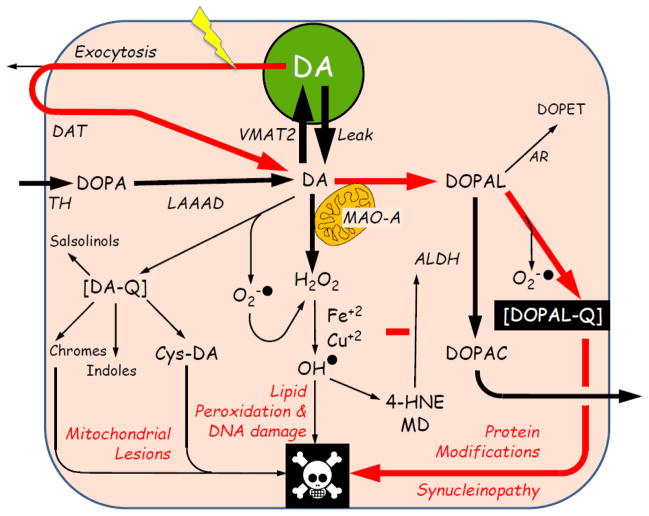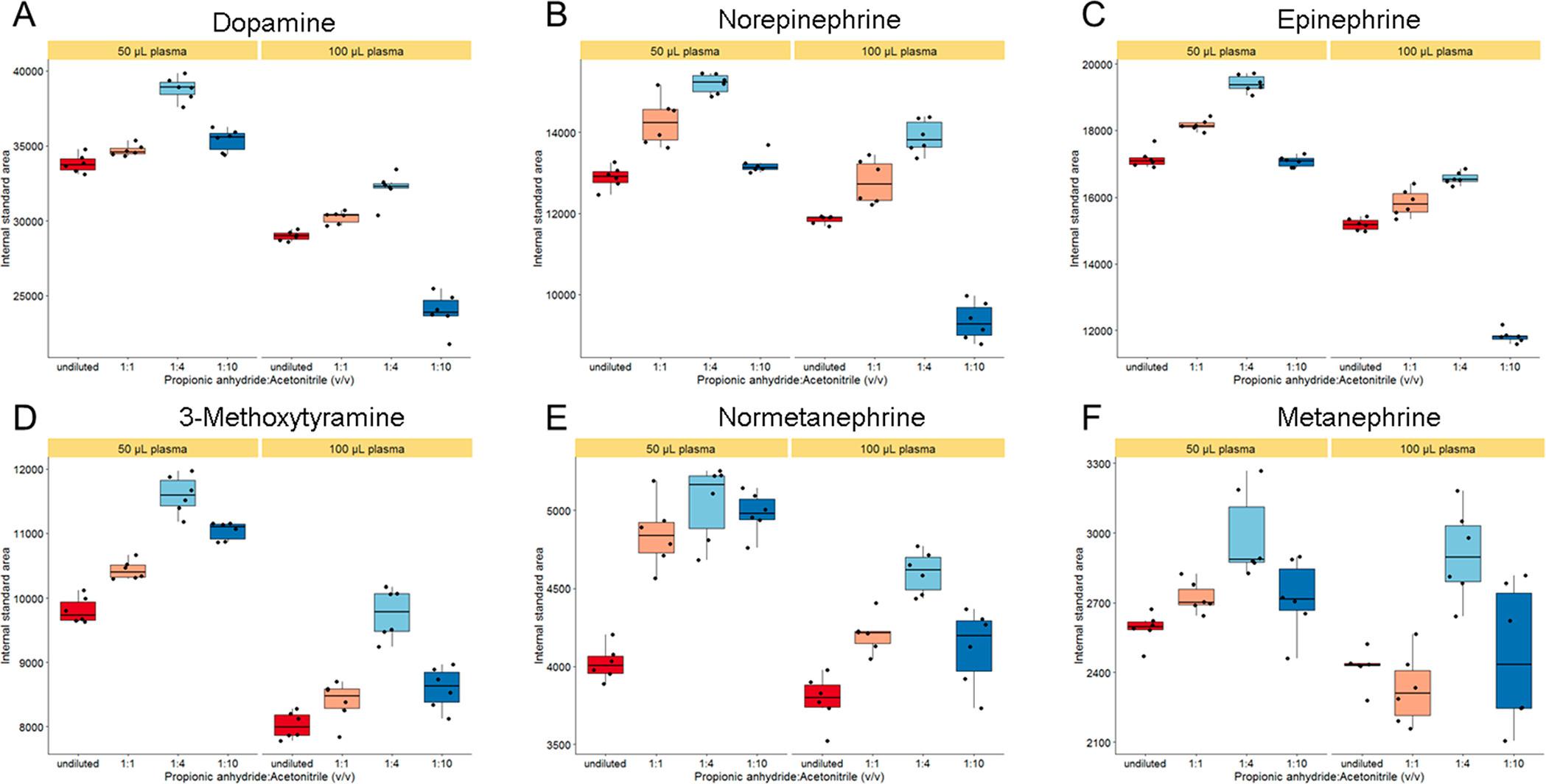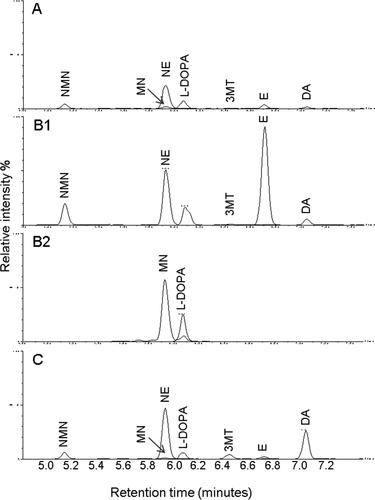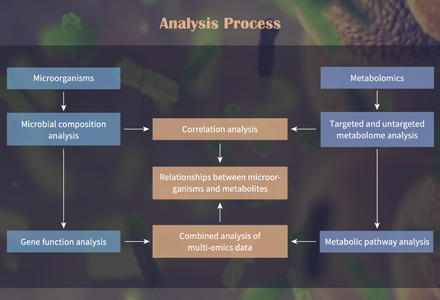Catecholamine Analysis Service
Submit Your Inquiry- Service Details
- Case Study
What is Catecholamine?
Catecholamines are substances containing catechol and amine groups, which play an important role in brain and nerve signal transmission, and are closely related to human health and Parkinson's disease and other neurological and mental diseases. Catecholamines mainly include epinephrine, isoproterenol, epinephrine, dopamine and related derivatives. These substances are not only important neurotransmitters in the body, but also important hormones, which are closely related to a variety of physiological and pathological phenomena. Related, it plays a key role in maintaining the body's homeostasis balance. The content of catecholamines in biological samples is low, the matrix is complex, and the response signal of its own fluorescence or mass spectrometry detection is not strong, and the sample after isotope derivatization can have high sensitivity, good selectivity, strong anti-matrix interference ability, and high-throughput and accurate determination in LC-MS/MS with the characteristics of simultaneous detection of multiple components. We use d0/d3-10-methyl-acridone-2-sulfonyl chloride (d0/d3-MASC) as the isotope-encoded derivatization reagent, combined with ultrasonic-assisted dispersion liquid-liquid microextraction technology and UPLC-MS/MS rapid analytical method for the determination of catecholamines.
 Figure 1. Overview of the catecholamine autotoxicity theory. (Goldstein 2018).
Figure 1. Overview of the catecholamine autotoxicity theory. (Goldstein 2018).
Advantages of Our Catecholamine Analysis Service
- Analytical technology is strong against matrix interference
- Use triple quadrupole mass spectrometer to obtain high-sensitivity analysis report
- High sensitivity and high precision analysis results
- Simplified operation process and fast turnaround time
- UPLC-MS/MS platform for accurate determination of catecholamines and their metabolites
Workflow of Catecholamine Analysis
The d0-MASC and d3-MASC were used to derive the microanalysis fluid sample and the reference substance, and the mixture was enriched and purified by the dispersion liquid-liquid microextraction technique, and then detected by UPLC-MS/MS, and quantified with the internal standard substance of the derivative. Samples can be quickly separated and detected, with good peak shape and resolution. LC-MS is used for detection, quantitative analysis results of trace sample substances.
 Figure 2. Catecholamine analysis service workflow.
Figure 2. Catecholamine analysis service workflow.
Detection method: standard curve method, isotope coding derivation
Mobile phase: A is methanol, B is 0.1% (volume fraction) formic acid water
Gradient elution conditions: 0-2 min: 50%-90%A; 2-3 min: 90%-100%A; 3-5 min: 100%-50% A
Injection volume: 5 μl
Flow rate: 0.5 ml/min
Elution mode: gradient elution
Analysis time: 3 min
Detection limit: 0. 005-0.010 nmol/l
Correlation coefficient: ≥ 0.995
Lower limit of quantification: 0.018-0.040 nmol/l
Reactive ion: positive ion electrospray ionization (ESI)
Monitoring mode: Multi-reaction monitoring mode of triple quadrupole mass spectrometry
Capillary voltage: 3.0 kV
Desolventizing gas (nitrogen) flow rate: 800 l/h
Cone gas (nitrogen) flow rate: 50 l/h
Collision gas (helium) flow rate: 0.16 ml/min
Retention time: ≤ 0.6 min
Standard deviation: 3.7%
Average matrix effect: 99.3%
Analysis content:
- Construction of standard straight lines
- Isotope code derivation and sample pretreatment
- Ultrasound-assisted dispersion liquid-liquid microextraction
- Optimization of UPLC-MS/MS conditions and quantitative methods
- Optimization of mass spectrometry acquisition conditions for derivatives
- Optimization of UA-DLLME conditions
- Precision, accuracy and stability test
- Linearity, detection limit and lower limit of quantification analysis
- Matrix effect analysis
- Chromatogram raw image and data collection
- Determination of catecholamine and its metabolites
Detectable Catecholamines and Metabolites — Metabolomics Panel
| Analyte | Class | Typical Pathway / Origin |
| Dopamine | Catecholamine | Core neurotransmitter in the catecholamine pathway |
| Epinephrine (Adrenaline) | Catecholamine | Secreted by adrenal medulla; stress response |
| L-3,4-Dihydroxyphenylalanine | Precursor | Formed from L-tyrosine via hydroxylation |
| 3,4-Dihydroxyphenylacetic acid | Metabolite | Oxidative deamination of dopamine (MAO) |
| Homovanillic acid | Terminal metabolite | DOPAC → HVA via COMT |
| 3-Methoxytyramine | Metabolite | O-methylation of dopamine (COMT) |
| Metanephrine | Metabolite | O-methylation of epinephrine (COMT) |
| Vanillylmandelic acid | Terminal metabolite | Downstream endpoint of catecholamine turnover |
| 3,4-Dihydroxyphenylethanol | Metabolite | Reduction/derivation within dopamine pathway |
| 3,4-Dihydroxyphenylglycol | Metabolite | Aldehyde reduction within catecholamine catabolism |
| Catechol sulfate conjugates | Conjugate | Phase II sulfation products |
| Catechol glucuronide conjugates | Conjugate | Phase II glucuronidation products |
| L-Tyrosine | Precursor | Amino-acid precursor feeding into pathway |
Sample Preparation of Catecholamines Analysis
- Animal and clinical tissue samples: 50mg/sample
- Blood samples (serum, plasma and whole blood): 50ul/sample
- Urine sample: 50ul/sample
- Stool and intestinal contents: 25mg/sample
- Body fluid samples (cerebrospinal fluid, saliva, etc.): 25mg/sample
- Plant tissue samples (roots, stems, leaves, fruits, etc.): 50mg/sample
- Cells and microbial cells: 1x106/sample
- Medium and fermentation broth: 50ul/sample
- Sample storage and transportation: Store in liquid nitrogen or -80°C, and transport on dry ice.
Clinical samples, no less than 30 duplicates in a single group; animal samples, no less than 9 duplicates in a single group; cell and microbial samples, no less than 5 duplicates in a single group; other such as plant samples, no less than 7 duplicates in a single group repeat.
The samples include multiple sample types such as animals, plants and microorganisms, please contact us for details.
Delivery
- Comprehensive experimental procedure
- Sample pretreatment and derivatization treatment
- Optimization of chromatographic conditions and optimization of mass spectrometry acquisition conditions of derivatives
- The most selective analysis of HPLC-MS equipment parameters
- Chromatogram raw image and data analysis report
- Determination of catecholamines and their metabolites
- Customized analysis report
Applications of Catecholamine Analysis
Neuropharmacology Insights: Explore neurotransmission and synaptic signaling for the development of neuropharmacological agents targeting dopamine.
Drug Discovery and Development: Assess the impact of drug candidates on catecholamine levels to refine pharmacological interventions and enhance the efficiency of psychiatric medications.
Biomarker Discovery: Identify reliable biomarkers associated with physiological and pathological conditions, aiding in diagnostics and treatment response monitoring.
Pharmacokinetics and Metabolism Studies: Illuminate how drugs influence neurotransmitter levels and metabolism, optimizing dosages and ensuring drug safety and efficacy.
Preclinical Models for Psychiatric Disorders: Utilize catecholamine analysis in animal models to study neurochemical changes, accelerating the translation of promising compounds from laboratory to clinical trials.
Stress Response Research: Investigate the impact of drugs on catecholamine levels during stress, contributing to the development of interventions promoting stress resilience and mental well-being.
Precision Medicine: Tailor drug interventions based on individual catecholamine profiles, advancing the field of personalized medicine for enhanced treatment outcomes.
We use isotope coding derivatization-dispersive liquid-liquid microextraction/UPLC-MS/MS and LC-MS method to realize the analytical application of catecholamines. This method has good sensitivity and anti-matrix interference ability, and the method is accurate, fast, specific, and effective for detection. The content of catecholamines in multiple sample types can provide a good technical means for related medical tests and drug screening. Creative Proteomics is committed to providing you with more competitive analysis costs and rapid analysis technical methods to meet your high-throughput and high-sensitivity detection needs.
References
- Goldstein D S, Kopin I J. Linking Stress, Catecholamine Autotoxicity, and Allostatic Load with Neurodegenerative Diseases: A Focused Review in Memory of Richard Kvetnansky. Cellular and Molecular Neurobiology. 2018;38(1):13-24.
- Fernstrom J D, Fernstrom M H. Tyrosine, phenylalanine, and catecholamine synthesis and function in the brain. The American Journal of Psychiatry. 2007;137(6 Suppl 1):1539S-1548S.
Case: Simultaneous Analysis of Catecholamines, and Metanephrines in Plasma Using Automated LC-MS/MS with Direct-Matrix Derivatization
Background
Catecholamines and metanephrines serve as vital diagnostic markers for various conditions, including tumors and neurotransmitter disorders. Analyzing them simultaneously poses challenges due to low concentrations, oxidation susceptibility, and potential chromatographic interferences. Existing methods are often laborious, imprecise, and sample-intensive, emphasizing the need for a more sensitive and efficient approach.
Sample
The study utilized plasma samples, with a particular focus on overcoming challenges related to their low concentrations, oxidation sensitivity, and the need for precise extraction methods. The goal was to develop a method suitable for volume-limited studies, such as those using samples from biobanks or preclinical studies involving animals.
Technical Methodology
Reagents:
- LC-MS grade acetonitrile, isopropanol, methanol, formic acid, and ammonium acetate were sourced from reputable suppliers.
- Analytical purity chemicals such as glutathione, ascorbic acid, dipotassium hydrogen phosphate, pyridine, and hydrochloric acid were obtained from Merck Millipore.
- Stable deuterated isotopes for internal standards were procured from various suppliers.
Preparation of Stock Solutions, Calibrators, and Internal Standard Solutions:
- Stock solutions of analytes were prepared in 0.08 mol/L acetic acid and stored at -80 °C.
- Serial dilutions in ascorbic acid in water 0.04% (w/v) were performed to obtain working solutions.
- Calibrators were prepared by adding different volumes of working solution into a surrogate matrix (dialyzed plasma).
Optimization of the Derivatization Reaction:
- The volume of plasma (50 μL) and the ratio of propionic anhydride to acetonitrile (v/v) were optimized.
- Propionic anhydride dilutions (undiluted, 1:1, 1:4, and 1:10) were tested for their impact on internal standard peak-area responses.
- Other conditions, including buffer strength, pH, and incubation time, were optimized to enhance the derivatization reaction.
Derivatization Procedure:
- Aliquots of thawed plasma samples (50 μL) and calibrators were mixed with an internal standard working solution, dipotassium phosphate, and K2EDTA.
- Propionic anhydride in acetonitrile was added, and the mixture was vortexed for 15 minutes.
- After water addition and centrifugation, samples were injected onto the online solid-phase extraction (SPE) LC-MS/TS system.
Online SPE and LC-MS/MS:
- An automated Symbiosis Pharma system was used for online SPE and liquid chromatography.
- Online SPE was performed on Oasis HLB 30 μm SPE cartridges.
- Liquid chromatography utilized a Luna Phenyl-Hexyl column with a binary gradient system of 10 mM ammonium acetate and acetonitrile with formic acid.
- Mass spectrometry was conducted on a Waters Xevo TQ-MS in positive electrospray ionization mode.
Evaluation of Assay Performance:
- The method underwent rigorous validation, including assessments of imprecision, limit of quantification, linearity, carryover, recovery, and ion suppression.
- Stability of derivatives was tested by analyzing samples at T = 0 and after T = 72 h in the autosampler.
- Quality control (QC) plasma samples with low, medium, and high analyte levels were prepared for performance evaluation.
 Effect of different derivatization reaction conditions on the internal standard peak-area response for the three different catecholamines.
Effect of different derivatization reaction conditions on the internal standard peak-area response for the three different catecholamines.
 Derivatization reaction of dopamine with propionic anhydride. Formed derivative product is shown on the right side.
Derivatization reaction of dopamine with propionic anhydride. Formed derivative product is shown on the right side.
Results
Derivatization Optimization: A 1:4 propionic anhydride dilution in acetonitrile showed the highest internal standard area responses, improving detection sensitivity.
Assay Performance: Intraassay and interassay coefficients of variation were <8.2%, and mean recovery of added analytes ranged from 95% to 105%.
Method Comparison: The developed LC-MS/MS method demonstrated comparable or superior performance compared to established HPLC-ECD and HILIC LC-MS/MS methods for catecholamines and metanephrines.
Reference Intervals: Reference intervals for analytes were established in the supine position and aligned with previously reported values for plasma collected in a similar position.
 LC-MS/MS analyses of plasma from a healthy volunteer
LC-MS/MS analyses of plasma from a healthy volunteer
Reference
- van Faassen, Martijn, et al. "In matrix derivatization combined with LC-MS/MS results in ultrasensitive quantification of plasma free metanephrines and catecholamines." Analytical Chemistry 92.13 (2020): 9072-9078.







